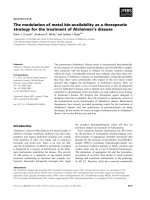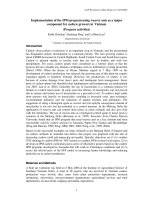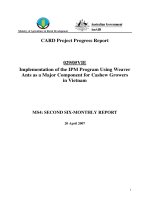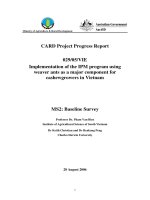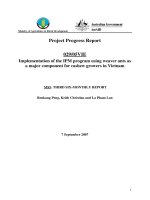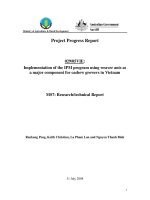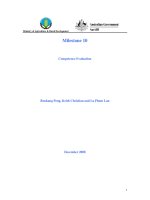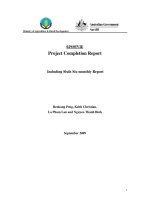Validation-Of-An-Enzyme-Linked-Immunosorbent-Assay-For-The-Quantification-Of-Citrullinated-Histone-H3-As-A-Marker-For-Neutrophil-Extracellular-Traps-In-Human-Plasma.pdf
Bạn đang xem bản rút gọn của tài liệu. Xem và tải ngay bản đầy đủ của tài liệu tại đây (1.03 MB, 7 trang )
Immunol Res
DOI 10.1007/s12026-017-8905-3
ORIGINAL ARTICLE
Validation of an enzyme-linked immunosorbent assay
for the quantification of citrullinated histone H3 as a marker
for neutrophil extracellular traps in human plasma
Charlotte Thålin 1 & Maud Daleskog 1 & Sophie Paues Göransson 2 & Daphne Schatzberg 3 &
Julie Lasselin 4,5 & Ann-Charlotte Laska 1 & Anders Kallner 6 & Thomas Helleday 7 &
Håkan Wallén 8 & Mélanie Demers 1
# The Author(s) 2017. This article is published with open access at Springerlink.com
Abstract There is an emerging interest in the diverse functions of neutrophil extracellular traps (NETs) in a variety of
disease settings. However, data on circulating NETs rely
largely upon surrogate NET markers such as cell-free DNA,
nucleosomes, and NET-associated enzymes. Citrullination of
histone H3 by peptidyl arginine deiminase 4 (PAD4) is central
for NET formation, and citrullinated histone H3 (H3Cit) is
considered a NET-specific biomarker. We therefore aimed to
optimize and validate a new enzyme-linked immunosorbent
assay (ELISA) to quantify the levels of H3Cit in human plasma. A standard curve made of in vitro PAD4-citrullinated
histones H3 allows for the quantification of H3Cit in plasma
using an anti-histone antibody as capture antibody and an antihistone H3 citrulline antibody for detection. The assay was
evaluated for linearity, stability, specificity, and precision on
plasma samples obtained from a human model of inflammation before and after lipopolysaccharide injection. The results
revealed linearity and high specificity demonstrated by the
inability of detecting non-citrullinated histone H3.
Coefficients of variation for intra- and inter-assay variability
ranged from 2.1 to 5.1% and from 5.8 to 13.5%, respectively,
allowing for a high precision. Furthermore, our results support
an inflammatory induction of a systemic NET burden by
showing, for the first time, clear intra-individual elevations
of plasma H3Cit in a human model of lipopolysaccharideinduced inflammation. Taken together, our work demonstrates
the development of a new method for the quantification of
H3Cit by ELISA that can reliably be used for the detection
of NETs in human plasma.
* Mélanie Demers
Keywords PAD4 . H3Cit . NETs . Elisa . Human plasma .
LPS-induced inflammation
1
Department of Clinical Sciences, Danderyd Hospital, Division of
Internal Medicine, Karolinska Institutet, Stockholm, Sweden
2
Department of Clinical Sciences, Danderyd Hospital, Department of
Anesthesia and Intensive Care, Karolinska Institutet,
Stockholm, Sweden
3
Department of Biology, Boston University, Boston, MA 02215, USA
4
Stress Research Institute, Stockholm University, Stockholm, Sweden
5
Department of Clinical Neuroscience, Division of Psychology,
Karolinska Institutet, Solna, Stockholm, Sweden
6
Department of Clinical Chemistry, Karolinska University Hospital,
Stockholm, Sweden
7
Department of Medical Biochemistry and Biophysics, Division of
Translational Medicine and Chemical Biology, Karolinska Institutet,
Science for Life Laboratory, Stockholm, Sweden
8
Department of Clinical Sciences, Danderyd Hospital, Division of
Cardiovascular Medicine, Karolinska Institutet, Stockholm, Sweden
Introduction
Neutrophil extracellular traps (NETs) are webs of chromatin
fibers (DNA and histones) coated with antimicrobial granular
proteins including the enzymes neutrophil elastase (NE) and
myeloperoxidase (MPO). Released by neutrophils into the
extracellular space upon activation, NETs were discovered
to trap and kill bacteria as part of the innate immune system
over a decade ago [1] and have since then been implicated in
several pathological conditions. In addition to a prothrombotic activity in deep vein thrombosis [2, 3], acute coronary syndrome [4–6] and ischemic stroke [7–9], NETs have
been shown to impair fibrinolysis and induce tissue and organ
damage in sepsis [10, 11], promote the autoimmune response
Immunol Res
in small vessel vasculitis [12], contribute to endothelial damage in systemic lupus erythematosus [13, 14], and acute lung
injury [15], as well as impair wound healing in diabetes [16].
A role in cancer is also emerging, where NETs have been
implicated in cancer-associated thrombosis [17], tumor
growth, and progression [18, 19]. In light of the emerging data
on the adverse role of NETs, pre-clinical studies are now
starting to explore the possibility of alleviating the effects of
NETs with new therapeutic agents that degrade NETs or inhibit their formation [3, 8, 20]. In this context, a reliable and
specific biomarker of NETs would play a central role in prediction of risk, prognosis, and therapeutic effects.
Studies of NET formation in the above disease settings rely
largely upon in vitro stimulation of neutrophils and subsequent NET formation assessing the susceptibility of neutrophils to undergo NETosis. Quantification of surrogate NET
markers in plasma, such as cell-free DNA (cfDNA), nucleosomes, and the NET-associated enzymes NE and MPO by
commercially available enzyme-linked immunosorbent assay
(ELISA) kits, has also been implemented. Data obtained with
these assays should be interpreted with caution, as events unrelated to NETosis, such as tissue injury, apoptosis, and necrosis, may generate circulating cfDNA as well as nucleosomes, whereas circulating NE and MPO may reflect neutrophil and/or macrophage activation not related to NET generation. Some studies also identified circulating levels of MPODNA complexes using a capture ELISA [11, 12, 21].
However, MPO is a highly positively charged secreted protein
[22], which can bind to the negatively charged cfDNA released in the plasma following tissue injury, thus questioning
its specificity as a NET marker.
Prior to releasing NETs, peptidylarginine deiminase 4
(PAD4), an enzyme that is primarily expressed in neutrophils,
translocates to the nucleus and converts peptidylarginine to
peptidylcitrulline on histone H3. The citrullination of positively charged arginine residues leads to uncharged citrulline residues, loss of ionic interactions, and subsequent chromatin
decondensation, the initial step of NETosis. Citrullinated
Histone H3 (H3Cit) is thereby considered a NET-specific biomarker [23].
An assay to estimate the levels of the NET biomarker
H3Cit in plasma would allow for a more specific assessment
of a circulating NET burden. We therefore aimed to validate
and optimize an ELISA-based assay recently shown to detect
H3Cit in plasma of patients with ischemic stroke [9].
Cell Death Detection ELISA PLUS kit, Roche, Cat. No. 11 774
425 001). Phosphate buffered saline (PBS; Life Technologies,
Cat. No. 14190-250), tween 20 (Sigma-Aldrich, Cat. No.
A9418), rabbit polyclonal anti-histone H3 (citrulline R2 + R8
+ R17) antibody (Abcam, Cat. No. AB5103), bovine serum
albumin, BSA (Sigma-Aldrich, Cat. No. A9418), goat antirabbit IgG horseradish-peroxidase (HRP) conjugate (BioRad,
Cat. No. 170-6515), 3,3′, 5,5′-tetramethylbenzidine (TMB) liquid substrate (Sigma-Aldrich, Cat. No. T0440), stop solution
(Thermo Scientific, Cat. No. N600), Trizma base (SigmaAldrich, Cat. No. T1503), CaCl2 (Sigma-Aldrich C1016),
phenylmethylsulfonyl fluoride (PMSF) protease inhibitor
(Life Technologies, Cat. No. 36978), dithiothreitol, DTT
(Invitrogen, Cat. No. P2325), human recombinant PAD4
(Cayman Chemical, Cat. No. 10500), human recombinant histone H3 (Cayman Chemical, Cat. No. 10263), ELISA reader
(Tecan Sunrise)
Preparation of standard
A working stock solution of H3Cit was made as described
previously [24]. Briefly, human recombinant PAD4 and human recombinant histones H3 at a ratio 2.5 U of PAD4 per
microgram of histones were incubated at 37 °C for 1 h in
reaction buffer (50 mM Trizma base with 4 mM CaCl2,
pH 7.6, 4 mM DTT, and 1 mM PMSF). A final concentration
of 10,000 ng/mL H3Cit was obtained by adding PBS-1%
BSA. The stock solution was aliquoted, frozen on dry ice,
and stored at −80 °C until later use.
Samples
Samples were taken from healthy individuals prior to and 3–
4 h after receiving intravenous injection of lipopolysaccharide
(LPS; 2 ng/kg of body weight Escherichia coli endotoxin, Lot
H0K354 CAT number 1235503, United States Pharmacopeia,
Rockville, MD, USA) or from healthy volunteers. Plasma
samples were prepared from citrated whole blood following
immediate centrifugation for 20 min at 2000×g after which they
were stored at −80 °C until further analysis. At time of analysis, samples were thawed on ice and diluted 1:2 in PBS
unless otherwise indicated. All study individuals gave written
informed consent for the use of their plasma, and the study
complied with the Declaration of Helsinki.
ELISA methodology
Materials and methods
Reagents and equipment
Microplates with 96 streptavidin pre-coated wells, monoclonal
anti-histone-biotin antibodies, and incubation buffer (all from
The microplate and diluents were kept at room temperature
30 min prior to starting the assay. Stock solution, antibodies,
and samples were thawed on ice and kept on ice until loading
of microplate. All incubations were at room temperature and
washes were repeated four times with PBS-Tween (0.05%)
with 20 s soaking for each wash. The concentrations of the
Immunol Res
standard curve, incubation times, and dilutions of samples
were optimized in preliminary experiments.
The assay was performed as follows (Fig. 1): 100 μL of
anti-histone biotin (1:10 in incubation buffer) was added to
Streptavidin pre-coated wells and incubated for 2 h. After
washing, 50 μL of standard solutions or samples was added
to each well and incubated for 1.5 h, then washed again.
100 μL of anti-histone H3 (citrulline R2 + R8 + R17; antiH3Cit) antibody (1:2000 in 1% BSA in PBS) was applied to
each well for 1 h incubation. After washing, the wells were
incubated for another hour with 100 μL anti-rabbit HRP conjugate antibody (1:5000 in 1% BSA in PBS), followed by
washing. For detection, 100 μL TMB was added to each well
and incubated for 20 min in the dark. The reaction was stopped
by adding 50 μL stop solution. The optical density (O.D.) was
measured at a wavelength of 450 nm with a reference correction
wavelength at 620 nm using an automatic plate reader.
effect of the matrix were assessed by spiking plasma samples
from four healthy volunteers with known concentrations of
in vitro PAD4-citrullinated histone H3, comparing this to the
detector response obtained for the same concentrations of
in vitro PAD4-citrullinated histone H3 diluted in PBS-1%
BSA. Precision was expressed by the intra- and inter-assay
coefficient of variation (%CV, defined as the ratio between
standard deviation and mean value). The maximum accepted
%CV for intra- and inter-assay variability were set to 15%.
Stability was assessed by comparing the detector response
obtained from freshly prepared and frozen aliquots of H3Cit
standard and comparing standard curves from frozen aliquots
from three different batches of H3Cit that had been
citrullinated on three different days. One versus two freezethaw cycles of plasma samples were also compared.
Assay validation
O.D. was fitted versus nominal log concentration applying a
sigmoidal 4PL regression to the calibration curve. 4PL curves
were compared by F-test. Data were analyzed using GraphPad
Prism 6 (GraphPad Software, Inc., La Jolla, CA, USA).
For validation of the assay, we assessed the following: linearity, stability, limit of detection, specificity, recovery, and precision. Trueness could not be determined as no reference analyte of known concentration is available, and there is no
available assay for the quantification of H3Cit in plasma for
comparison. The linear interval was defined as the linear section of the best-fit standard curve. Each standard curve was
fitted using a four-parameter logistic (4PL) regression, and the
95% confidence interval (95% CI) was considered. The limit
of detection was approximated from the intersection of the
lower asymptote of the upper 95% CI with the 4PL fit of the
standard data. Specificity was assessed by the ability to detect
citrullinated histone H3 but not non-citrullinated histone H3 in
similar conditions by preparing a standard without PAD4, thus
preventing the citrullination of histone H3. Recovery and the
Fig. 1 Schematic of the H3Cit
ELISA procedure. A Anti-histone
biotin (the capture antibody) is
coated to streptavidin pre-coated
wells during the first incubation.
Samples are pipetted into the
wells and histones bind to the
capture antibody during the
second incubation. B After
washing, anti-H3Cit is added to
the wells, binding to immobilized
H3Cit but not to histones H3 that
are not citrullinated, during the
third incubation. C In the fourth
incubation, an HRP conjugated
anti-rabbit antibody is added and
binds to the anti-H3Cit, after
which TMB is added for detection
Statistical analyses
Results
Standard preparation and linearity
As no international standard preparation is available for
H3Cit, we generated a standard curve using in vitro PAD4citrullinated H3Cit, as previously described [24]. The stock
was serially diluted 1:2 in PBS-1% BSA to obtain a standard
curve and applied to a streptavidin-coated plate using an antihistone biotin antibody as capture and an anti-H3Cit antibody
for detection. To determine the suitable linear interval, we
Immunol Res
interpolated the detected O.D. from the serial dilutions of
H3Cit to different regressions. The best-fit curve was a sigmoidal 4PL curve rendering a linear interval of the curve
between ≈ 0.3 and 3.5 O.D., corresponding to concentrations
between ≈5 and ≈300 ng/mL (Fig. 2a).
Stability
The detector response when preparing standards from freshly
citrullinated H3Cit was very similar to the detector response
obtained from frozen aliquots of the same standards (Fig. 2b).
Moreover, the detector response when preparing standard
curves from frozen aliquots from three different batches of
H3Cit citrullinated on three different days were not significantly different (Fig. 2a), allowing for a good reproducibility.
the standard curve. The limit of detection with stated probability was therefore set to approximately 5 ng/mL.
Specificity
To assess the specificity of the assay, we prepared a standard
curve with histone H3 incubated under the same conditions as
our standard preparation of H3Cit, but without PAD4, rendering non-citrullinated histones, and compared this to our standard curve with in vitro PAD4-citrullinated H3Cit. Although
there was a low amount of antibody antigen detection when
large amounts of non-citrullinated histone H3 were present,
the antibody antigen detection was specific for citrullinated
H3Cit in the linear interval of the assay (Fig. 2c).
Effect of the matrix
Limit of detection
To determine the limit of detection, we approximated the lowest detectable concentration determined from the curve to
≈5 ng/mL. This concentration corresponded to the intersection
of the lower asymptote of the upper 95% CI with the 4PL fit of
Fig. 2 In vitro PAD4citrullinated histone H3 standard.
a Standard curves. The detector
response when preparing standard
curves from frozen aliquots from
three different batches of PAD4citrullinated histone H3 on three
different days (STD 1–3) were not
significantly different (F (DFn,
DFd) = 2.6 (8, 9); p = 0.088). b
Standard curves generated from
freshly made or frozen aliquot of
H3Cit standards. No significant
difference was observed when
comparing the detector response
of the freshly made versus frozen
standards (F (DFn, DFd) = 0.2 (4,
52); p = 0.916. c Data obtained
when a standard curve was
prepared with histone H3
incubated in the same conditions
as our standard preparation of
H3Cit, but without PAD4,
rendering non-citrullinated
histones, representative of three
different experiments. There was
a low amount of antibody antigen
detection when large amounts of
non-citrullinated histone H3 were
present, but the antibody antigen
detection was specific for H3Cit
in the linear interval of the assay
To evaluate whether components of the sample matrix (i.e.,
plasma), such as proteins, phospholipids, carbohydrates, or
various metabolites, interfered with the binding of H3Cit to
either the capture antibody or the detection antibody, we
spiked known concentrations of H3Cit to plasma diluted 1:2
Immunol Res
from four healthy volunteers. This gave a significantly lower
detector response compared to the detector response obtained
from the standard diluted in PBS-1% BSA (Fig. 3a), suggesting an effect of the matrix. To further study this effect, we
prepared the standard in pooled plasma from healthy donors
diluted 1:20, 1:10, and 1:5 in PBS, rendering a dose response
of the detector with increasing dilutions of plasma (Fig. 3b).
However, the citrullinated histones used for these spiking experiments were free citrullinated histones, as opposed to the
citrullinated histones in our samples which are hypothesized
to be bound to cfDNA in nucleosomes, suggesting that there
are components in plasma either interfering with the antibody
detection of free histones or degrading free histones in plasma,
aggravating the attempt to recover free histones in plasma.
Concentrations of H3Cit in plasma in a human model
of LPS-induced inflammation
Surrogate markers of NETs (cfDNA, nucleosomes and MPODNA complexes) have been identified in the plasma of septic
patients [10, 11, 25, 26] and in murine models of lipopolysaccharide (LPS)-induced septic shock [11, 27, 28]. Furthermore,
H3Cit was detected by western blot in plasma of mice shortly
after LPS injection [27, 28]. With the intention to perform the
assay validation with samples containing H3Cit, we therefore
used samples from healthy volunteers receiving intravenous
LPS in an experimental model of inflammation. The samples
were taken at baseline (before LPS injection) and after 3–4 h,
with the hypothesis that LPS injection would induce a systemic NET formation resulting in elevated and detectable levels of
H3Cit in plasma. Indeed, the levels of H3Cit in all samples
taken at baseline were under the detection limit of approximately 5 ng/mL, and the levels of H3Cit in all samples taken
from the same individuals 3–4 h after LPS injection ranged
from 28.7 to 93.2 ng/mL (Fig. 3c). These concentrations were
all calculated from detection of optical density within the linear interval of the standard curve following a 1:2 dilution of
plasma samples (Fig. 2a). However, repeated freeze-thaw cycles of plasma samples with known concentrations of H3Cit
rendered a mean reduction of 13.4 ± 2.3% after a second
freeze-thaw cycle. Freeze-thaw cycles of the plasma are therefore not recommended when applying this assay.
Precision and reproducibility
To assess the precision of the assay, we performed the assay
on six replicates of eight samples (1-8) within the same assay
run as well as duplicates of the same eight samples in four
different assay runs performed on four different days. The CV
were all <15%, with the intra-assay ranging from 2.13 to
5.15% and the inter-assay ranging from 5.80 to 12.55%,
showing a high precision with good repeatability and reproducibility of the assay (Table 1).
Discussion
Fig. 3 Detection of H3Cit in plasma samples. a At baseline, no H3Cit was
detected in plasma from healthy volunteers, whereas the spiking of known
concentrations of H3Cit into these plasmas diluted 1:2 gave a significantly
lower detector response compared to the detector response obtained from
the standard diluted in PBS-1% BSA, suggesting an effect of the matrix. b
Standards prepared from H3Cit diluted in pooled plasma from healthy
donors at various dilutions, rendered an obvious increase in detector
response with increasing dilutions of plasma. c The quantification of
H3Cit in plasma of healthy volunteers before LPS injections were under
the detection limit of approximately 5 ng/mL. An increase in the levels of
H3Cit in all plasma samples taken from the same individuals 3–4 h after
LPS was observed, ranging from 28.7 to 93.2 ng/mL
Our study establishes an assay allowing for the fast and reliable quantification of the NET-specific biomarker H3Cit in
human plasma. We also show, for the first time, an elevation
of H3Cit in plasma in a human model of LPS-induced
inflammation.
The validation of the assay revealed a high specificity for
H3Cit as well as a high stability of the custom-made standard,
rendering a good precision and reproducibility. Although we
show a clear dose-dependent effect of the matrix on the detection of free citrullinated histones added to plasma, we can only
speculate on whether the citrullinated histones in our samples
Immunol Res
Table 1
Precision, intra-assay repeatability, and four different days inter-assay reproducibility
Sample
1
2
3
4
5
6
7
8
Coefficient of variation (%) intra-assay (n = 6)
5.1
4.5
5.08
2.7
4.35
3.58
2.13
3.1
Coefficient of variation (%) inter-assay (n = 4)
11.54
10.27
12.55
8.5
9.6
10.53
5.8
13.5
are protected by surrounding DNA as part of nucleosomes.
Free histones are highly positively charged and have been
shown to bind to negatively charged components such as proteins and heparins in plasma [29], potentially blocking the
binding sites of the antibodies in the assay. Free histones have
also been shown to bind to phospholipids such as
phosphatidylserine and phosphatidylethanolamine present on
microparticles [30], as well as to platelets [31] and platelet
adhesion molecules such as vWF and fibrinogen [32].
Furthermore, histones could in their free form be subject to
rapid degradation by free proteases within the plasma such as
activated protein C [33], or the NET-associated enzymes NE,
MPO [34], and cathepsins [35]. Indeed, the degradation of
free histones in plasma was recently shown by western blotting assessing histone degradation over time in plasma from
healthy volunteers spiked with free calf thymus histones, revealing a very rapid degradation with a half-life of 4.6 min
[36]. However, H3Cit bound to DNA in nucleosomes, the
endpoint of interest in the detection and quantification of circulating NETs, could be protected against degradation and/or
further binding and subsequent blocking of the antibody binding site in the assay. It is therefore our hypothesis that the
amount of H3Cit quantified by this assay is in fact the amount
of H3Cit protected by the NET complex, excluding a possible
portion of free H3Cit in plasma. On the other hand, the standard of H3Cit used in our assay comprises in vitro citrullinated
H3Cit, and the concentration of H3Cit in the standard
curve is therefore an estimation based on the assumption
that all histones were citrullinated, assuming the optimal
enzymatic activity of PAD4 at a ratio of 2.5 U/μg of
histones. A possible underestimation of the concentration
in our samples can therefore not be ruled out. However,
the assay provides a reproducible estimate of the concentrations of detectable H3Cit in plasma with high specificity, stability, and precision, rendering a robust and reliable
assay for the comparison of the levels of detectable H3Cit
in human plasma.
Interestingly, all samples taken at baseline in the LPSinduced model of inflammation were below the limit of
detection, suggesting that healthy people do not have a
baseline systemic NET burden. This is in line with a
recent study revealing a low amount of H3Cit in plasma
of healthy individuals when applying a similar assay but
without concentrations derived from a standard curve [9].
Furthermore, in accordance with previous studies showing
elevations of surrogate markers of NETs in septic patients
[10, 11, 25, 26] as well as the detection of H3Cit by western
blotting in murine models of LPS-induced septic shock [27,
28], our results support an inflammatory induction of a systemic NET burden by showing clear intra-individual elevations of H3Cit in healthy individuals receiving LPS injection. Further studies are now warranted to confirm these
elevations in a clinical setting of sepsis.
There is an emerging interest in the role of NETs in various
disease settings. Apart from its role as a central player of the
innate immune system in both bacterial [1, 10, 11, 25–28, 33,
36] and viral infection [15, 37], NETs are now being implicated in several common and widespread diseases such as arterial
and venous thrombosis [2–9], cancer [17–19], and diabetes
[16]. Prior studies rely largely upon the detection and quantification of surrogate markers of NETs, such as cfDNA, NE,
and MPO. There is therefore an unmet need for a more specific assessment of a systemic NET burden to explore the
potential of NETs in disease prediction and progression.
Moreover, with the use of a detection antibody widely shown
to recognize citrullinated histone H3 in plasma and cells from
mouse and human [9, 16, 17, 19, 38] we believe that our
method has the potential to detect NET burden not only in
human plasma but also in disease mouse models and in vitro
research.
In conclusion, we believe that this assay could be of great
value in further studies of a systemic NET burden. If quantifiable levels of H3Cit in plasma prove to be useful as a prognostic marker in conditions such as sepsis or prediction of
diseases such as thrombosis and cancer, further development
of this assay would allow for its implementation in several
clinically important settings.
Acknowledgements We thank Elisee Wiita, Lena Gabrielsson,
Katherina Aguilera, and Ann-Christine Samuelsson for their help and
assistance with the study. This work was supported by the Helleday
Foundation (C.T.) and the Torsten and Ragnar Söderberg Foundation
(T.H.).
Open Access This article is distributed under the terms of the Creative
Commons Attribution 4.0 International License (http://
creativecommons.org/licenses/by/4.0/), which permits unrestricted use,
distribution, and reproduction in any medium, provided you give appropriate credit to the original author(s) and the source, provide a link to the
Creative Commons license, and indicate if changes were made.
Immunol Res
References
1.
2.
3.
4.
5.
6.
7.
8.
9.
10.
11.
12.
13.
14.
15.
16.
17.
18.
Brinkmann V, Reichard U, Goosmann C, et al. Neutrophil extracellular traps kill bacteria. Science. 2004;303:1532–5.
Fuchs TA, Brill A, Duerschmied D, et al. Extracellular DNA traps
promote thrombosis. Proc Natl Acad Sci U S A. 2010;107:15880–
5.
Brill A, Fuchs TA, Savchenko A, et al. Neutrophil extracellular
traps promote deep vein thrombosis in mice. J Thromb Haemost.
2012;10:136–44.
Mangold A, Alias S, Scherz T, et al. Coronary neutrophil extracellular trap burden and DNase activity in ST-elevation acute coronary
syndrome are predictors of ST-segment resolution and infarct size.
Circ Res. 2015;116:1182–92.
De Boer OJ, Li X, Teeling P, et al. Neutrophils, neutrophil extracellular traps and interleukin-17 associate with the organisation of
thrombi in acute myocardial infarction. Thromb Haemost.
2013;109:290–7.
Savchenko A, Borissoff J, Martinod K, et al. VWF-mediated leukocyte recruitment with chromatin decondensation by PAD4 increases myocardial ischemia/reperfusion injury in mice. Blood.
2014;123:141–8.
Perez-de-Puig I, Miró F, Ferrer Ferrer M, et al. Neutrophil recruitment to the brain in mouse and human ischemic stroke. Acta
Neuropathol. 2015;129:239–57.
De Meyer S, Suidan G, Fuchs T, et al. Extracellular chromatin is an
important mediator of ischemic stroke in mice. Arterioscler Thromb
Vasc Biol. 2012;32:1884–91.
Thalin C, Demers M, Blomgren B, et al. NETosis promotes cancerassociated arterial microthrombosis presenting as ischemic stroke
with troponin elevation. Thromb Res. 2016;139:56–64.
Gould TJ, Vu TT, Stafford AR, et al. Cell-free DNA modulates clot
structure and impairs fibrinolysis in sepsis. Arterioscler Thromb
Vasc Biol. 2015;35:2544–53.
Czaikoski PG, Mota JM, Nascimento DC, et al. Neutrophil extracellular traps induce organ damage during experimental and clinical
sepsis. PLoS One. 2016; doi:10.1371/journal.pone.0148142.
Kessenbrock K, Krumbholz M, Schönermarck U, et al. Netting
neutrophils in autoimmune small-vessel vasculitis. Nat Med.
2009;15:623–5.
Villanueva E, Yalavarthi S, Berthier CC, et al. Netting neutrophils
induce endotelial damage, infiltrate tissues and expose
immunostimulatory molecules in systemic lupus erythematosus. J
Immunol. 2011;187:538–52.
Hakkim A, Fürnrohr G, Amann K, et al. Impairment of neutrophil
extracellular trap degradation is associated with lupus nephritis.
PNAS. 2010;107:9813–8.
Narasaraju T, Yang E, Samy RP, et al. Excessive neutrophils and
neutrophil extracellular traps contribute to acute lung injury of influenza pneumonitis. Am J Pathol. 2011;179:199–210.
Wong SL, Demers M, Martinod K, et al. Diabetes primes neutrophils to undergo NETosis, which impairs wound healing. Nat Med.
2015;21:815–9.
Demers M, Krause D, Schatzberg D, et al. Cancers predispose
neutrophils to release extracellular DNA traps that contribute to
cancer-associated thrombosis. Proc Natl Acad Sci U S A.
2012;109:13076–81.
Cools-Lartigue L, Spicer J, McDonald B, et al. Neutrophil extracellular traps sequester circulating tumor cells and promote metastasis.
J Clin Invest. 2013;123:3446–58.
19.
Demers M, Wong SL, Martinod M, et al. Priming of neutrophils
toward NETosis promotes tumor growth. OncoImmunology. In
Press.
20. Lewis H, Liddle J, Coote J, et al. Inhibition of PAD4 activity is
sufficient to disrupt mouse and human NET formation. Nat Chem
Biol. 2015;11:189–91.
21. Caudrillier A, Kessenbrock K, Gilliss BM, et al. Platelets induce
neutrophil extracellular traps in transfusion-related acute lung injury. J Clin Invest. 2012;122:2661–71.
22. Klebanoff SJ. Myeloperoxidase: friend and foe. J Leukoc Biol.
2005;77:598–625.
23. Leshner M, Wang S, Lewis C, et al. PAD4 mediated histone
hypercitrullination induces heterochromatin decondensation and
chromatin unfolding to form neutrophil extracellular trap-like structures. Front Immunol. 2012;3:307.
24. Li P, Yao H, Zhang Z, et al. Regulation of p53 target gene expression by peptidylarginine deiminase 4. Mol Cell Biol. 2008;28:
4745–58.
25. Margraf ST, Logters J, Reipen J, et al. Neutrophil-derived circulating free DNA (CFDNA/NETs): a potential prognostic marker for
posttraumatic development of inflammatory second hit and sepsis.
Shock. 2008;30:352–8.
26. Hashiba M, Huq A, Tomino A, et al. Neutrophil extracellular traps
in patients with sepsis. J Surg Res. 2015;194:248–54.
27. Li Y, Liu B, Ey F, et al. Identification of citrullinated histone H3 as a
potential serum protein biomarker in a lethal model of lipopolysaccharide-induced shock. Surgery. 2011;150:442–51.
28. Martinod K, Fuchs TA, Zitomersky NL, et al. PAD4-deficiency
does not affect bacteremia in polymicrobial sepsis and ameliorates
endotoxemic shock. Blood. 2015;125:1948–56.
29. Hoeksema M, van Eijk M, Haagsman HP, et al. Histones as mediators of host defense, inflammation and thrombosis. Future
Microbiol 2016; epub ahead of print.
30. Fürnrohr B, Groer G, Sehnert B, et al. Interaction of histones with
phospholipids—implications for the exposure of histones on apoptotic cells. Autoimmunity. 2007;40:322–6.
31. Fuchs T, Bhandari A, Wagner D. Histones induce rapid and profund
thrombocytopenia in mice. Blood. 2011;118:3708–14.
32. Ward CM, Tetaz TJ, Andrews RK, et al. Binding of the von
Willebrand factor A1 domain to histone. Thromb Res. 1997;86:
469–77.
33. Xu J, Zhang X, Pelayo R, et al. Extracellular histones are major
mediators of death in sepsis. Nat Med. 2009;15:1318–21.
34. Papayannopoulos V, Metzler KD, Hakkim A, et al. Neutrophil elastase and myeloperoxidase regulate the formation of neutrophil extracellular traps. J Cell Biol. 2010;191:677–91.
35. Ivanov A, Pawlikowski J, Manoharan I, et al. Lysosome-mediated
processing of chromatin in senescence. J Cell Biol. 2013;202:129–
43.
36. Ekaney ML, Otto GP, Sossdorf M, et al. Impact of plasma histones
in human sepsis and their contribution to cellular injury and inflammation. Crit Care. 2014;18:543.
37. Tripathi S, Verma A, Kim EJ, et al. LL-37 modulates human neutrophil responses to influenza A virus. J Leukoc Biol. 2014;96:931–
8.
38. Demers M, Wagner DD. NETosis: a new factor in tumor progression and cancer-associated thrombosis. Semin Thromb Hemost.
2014:277–83.


